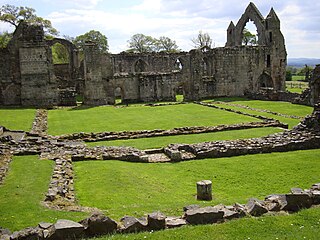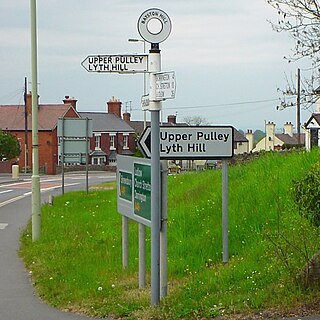
Baschurch is a village and civil parish in Shropshire, England. It lies in the north of Shropshire. The village had a population of 2,503 as of the 2011 census. Shrewsbury is to the south-east, Oswestry is to the north-west, and Wem is to the north-east of Baschurch. The village is also close to Ruyton-XI-Towns.

Shawbury is a village and civil parish in Shropshire, England. The village is 8 miles (13 km) northeast of Shrewsbury and 12 miles (19 km) northwest of Telford.

Haughmond Hill is a small, shallow hill in the English county of Shropshire. It is covered by woodland for the most part, although there is an open cast quarry in use. Its proximity to the town of Shrewsbury has meant that it has become something of a forest park, with guided paths, car parking and picnic areas maintained in places. The rocky summit overlooks countryside and Shrewsbury itself.

Haughmond Abbey is a ruined, medieval, Augustinian monastery a few miles from Shrewsbury, England. It was probably founded in the early 12th century and was closely associated with the FitzAlan family, who became Earls of Arundel, and some of their wealthier vassals and allies. It was a substantial, successful and wealthy house for most of its four centuries, although evidence of abuses appeared before its dissolution in 1539. The buildings fell into disrepair and the church was largely destroyed, although the remains of some of the domestic buildings remain impressive. The site is now in the care of English Heritage and is open to the public throughout the year and free entry.

Bayston Hill is a village and civil parish in Shropshire, England. It is 3 miles (5 km) south of the county town Shrewsbury and located on the main A49 road, the Shrewsbury to Hereford road.

Hodnet is a village and civil parish in Shropshire, England. The town of Market Drayton lies 5.7 miles (9.2 km) north-east of the village.

Uffington is a village and civil parish in the English county of Shropshire. The population of the civil parish at the 2011 census was 234. It lies between Haughmond Hill and the River Severn, 3 miles east from the town centre of Shrewsbury, at grid reference SJ53151395.

Longdon-Upon-Tern is a village in east central Shropshire, England. It is in the unitary district of Telford and Wrekin, and is approximately 11 kilometres (6.8 mi) east of Shrewsbury and 11 kilometres (6.8 mi) north-west of Telford. Longdon-Upon-Tern is situated on the River Tern, a tributary of the River Severn.

Withington is a village and parish in Shropshire, England.

Harley is a village and civil parish in the English county of Shropshire. The population of the civil parish at the 2011 census was 163.

Weston-under-Redcastle is an estate village of the Sir Rowland Hill legacy estates. It is a civil parish in Shropshire, England. It lies 10 km by road east of Wem. Historically, it has been part of the manor of Hawkstone.

John Plimmer was an English settler and entrepreneur in New Zealand who has been called the "Father of Wellington".

Cardington is a village and civil parish in Shropshire, England. It is situated south of Shrewsbury, near Caer Caradoc Hill, and the nearest town is Church Stretton. The parish also contains the villages of Enchmarsh and Plaish, and most of the parish is in the Shropshire Hills AONB.
William Hazledine was an English ironmaster. Establishing large foundries, he was a pioneer in casting structural ironwork, most notably for canal aqueducts and early suspension bridges. Many of these projects were collaborations with Thomas Telford, including the Pontcysyllte Aqueduct and the Menai Suspension Bridge.

Samuel Fisher was an English Puritan clergyman and writer, who was committed to a Presbyterian polity. After serving as a rural rector in Shropshire during the period of Charles I's absolute monarchy, he worked in London and Shrewsbury during the English Civil War and under the Commonwealth and in Cheshire during the Protectorate. After the Great Ejection of 1662 he settled in Birmingham, where he worked as a nonconformist preacher. The precise course of his career is a matter of some controversy.
Tibberton and Cherrington is a civil parish in the district of Telford and Wrekin, Shropshire, England. It contains 16 listed buildings that are recorded in the National Heritage List for England. Of these, one is at Grade II*, the middle of the three grades, and the others are at Grade II, the lowest grade. The parish contains the villages of Tibberton and Cherrington, and is otherwise rural. Almost all the listed buildings are timber framed houses and cottages, the earlier ones with cruck construction. The other listed buildings consist of red brick houses and a church.
Uffington is a civil parish in Shropshire, England. In the parish are 13 listed buildings that are recorded in the National Heritage List for England. Of these, one is listed at Grade I, the highest of the three grades, and the others are at Grade II, the lowest grade. The parish contains the village of Uffington, and is otherwise mainly rural. In the parish are the remains of Haughmond Abbey, which is listed at Grade I, and is also a Scheduled Monument. Also in the parish was Sundorne Castle, a country house that has been demolished. A number of structures associated with the house have survived, and are listed. The other listed buildings include houses, cottages, farmhouses and farm buildings, the earliest of which are timber framed, a pump in an enclosure, and a church.
Upton Magna is a civil parish in Shropshire, England. It contains 22 listed buildings that are recorded in the National Heritage List for England. Of these, two are listed at Grade II*, the middle of the three grades, and the others are at Grade II, the lowest grade. The parish contains the village of Upton Magna and is otherwise rural. The Shrewsbury Branch of the Shropshire Union Canal ran through the parish. It is now disused but three structures associated with it have been listed, namely a bridge and the entrances to a tunnel. In the village, most of the listed buildings are houses, cottages and associated structures, the earliest of these are timber framed. Also in the village and listed are a church and items in the churchyard. Outside the village, the other listed buildings include farmhouses and associated structures, a house and cottages.
Waters Upton is a civil parish in the district of Telford and Wrekin, Shropshire, England. It contains 29 listed buildings that are recorded in the National Heritage List for England. Of these, two are at Grade II*, the middle of the three grades, and the others are at Grade II, the lowest grade. The parish includes the villages of Waters Upton, Crudgington and Great Bolas, and is otherwise rural. Most of the listed buildings are houses and cottages and associated structures, farmhouses and farm buildings, the earliest of which are timber framed. The other listed buildings include two churches and associated structures, and a bridge.
















